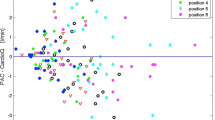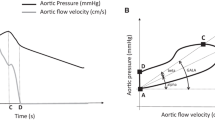Abstract
Purpose
The aim of this study was to investigate the ability of transesophageal photoplethysmography detected from the descending aorta (dPPG) for predicting low descending aortic stroke volume (dSV) level in cardiac surgical patients.
Methods
Fifteen patients scheduled for elective cardiac surgery were enrolled in our study. A transesophageal echocardiography (TEE) probe with an attached oximetry sensor was placed into the esophagus for paired dPPG signal and descending aortic Doppler blood flow signal acquisition. Metrics, including alternating current (AC), direct current (DC), area under the curve (AUC) and width (W), were extracted from the dPPG signals. The TEE-measured dSV, which was defined as the blood flow through the descending aorta during a cardiac cycle, was chosen as the standard reference. A receiver operating characteristic (ROC) curve was built to evaluate the performance of dPPG metrics in predicting low dSV level, and dSV measuring agreement between TEE and dPPG was analyzed by the Bland–Altman method.
Results
A total of 644 paired dPPG and Doppler signals of the descending aorta were acquired. Significant correlations were found between the dPPG metrics and TEE-measured dSV, and the correlation coefficients between TEE-measured dSV and AUC or AC were 0.64 and 0.66, respectively. AUC and AC values obviously decreased with the reduction of dSV level among the three groups (<20 mL, from 20−40 mL, and >40 mL). The areas under the ROC curve for AUC and AC in predicting low dSV level (<20 mL) were 0.85 and 0.88, respectively. Bland–Altman plot showed a small bias (0.02 mL) but a wide limit of agreement (−18.62 to 18.66 mL) in dSV measurement between dPPG and Doppler technology.
Conclusions
The AC and AUC extracted from the dPPG signal provided a sensitive and qualitative prediction for dSV level. The dSV value could not be accurately measured by dPPG metrics.
Trial Registration
Chinese Clinical Trials Register Identifier: ChiCTR-OCS-12002789.





Similar content being viewed by others
References
Sahni R. Noninvasive monitoring by photoplethysmography. Clin Perinato. 2012;39:573–83.
Scheeren TW, Schober P, Schwarte LA. Monitoring tissue oxygenation by near infrared spectroscopy (NIRS): background and current application. J Clin Monit Comput. 2012;26:279–87.
Shelley KH. Photoplethysmography: beyond the calculation of arterial oxygen saturation and heart rate. Anesth Analg. 2007;105:S31–6.
Alian AA, Galante NJ, Stachenfeld NS, Silverman DG, Shelley KH. Impact of central hypovolemia on photoplethysmographic waveform parameters in healthy volunteers. Part 1: Time domain analysis. J Clin Monit Comput. 2011;25:377–85.
Alian AA, Galante NJ, Stachenfeld NS, Silverman DG, Shelley KH. Impact of central hypovolemia on photoplethysmographic waveform parameters in healthy volunteers. Part 2: Frequency domain analysis. J Clin Monit Comput. 2011;25:387–96.
McGrath SP, Ryan KL, Wendelken SM, Richards CA, Convertino VA. Pulse oximeter plethysmographic waveform changes in awake, spontaneously breathing, hypovolemic volunteers. Anesth Analg. 2011;112:368–74.
Scully CG, Selvaraj N, Romberg FW, Wardhan R, Ryan J, Florian JP, Silverman DG, Shelley KH, Chon KH. Using time-frequency analysis of the photoplethysmographic waveform to detect the withdrawal of 900 ml of blood. Anesth Analg. 2012;115:74–81.
Thiele RH, Colquhoun DA, Patrie J, Nie SH, Huffmyer JL. Relationship between plethysmographic waveform changes and hemodynamic variables in anesthetized, mechanically ventilated patients undergoing continuous cardiac output monitoring. J Cardiothorac Vasc Anesth. 2011;25:1044–50.
Awadd AA, Stout RG, Ghobashy MA, Rezkanna HA, Silverman DG, Shelley KH. Analysis of the ear pulse oximeter waveform. J Clin Monit Comput. 2006;20:175–84.
Kyriacou PA, Powell S, Langford RM, Jones DP. Esophageal pulse oximetry utilizing reflectance photoplethysmography. IEEE Trans Biomed Eng. 2002;49:1360–8.
Margreiter J, Keller C, Brimacombe J. The feasibility of transesophageal echocardiograph-guided right and left ventricular oximetry in hemodynamically stable patients undergoing coronary artery bypass grafting. Anesth Analg. 2002;94:794–8.
Kyriacou PA, Powell S, Langford RM, Jones DP. Investigation of oesophageal photoplethysmographic signals and blood oxygen saturation measurements in cardiothoracic surgery patients. Physiol Meas. 2002;23:533–45.
Kyriacou PA, Moye AR, Choi DM, Langford RM, Jones DP. Investigation of the human oesophagus as a new monitoring site for blood oxygen saturation. Physiol Meas. 2001;22:223–32.
Wei W, Zhu Z, Liu L, Zuo Y, Gong M, Xue F, Liu J. A pilot study of continuous transtracheal mixed venous oxygen saturation monitoring. Anesth Analg. 2005;101:440–3.
Wang L, Wei W, Gong M, Mu L. A comparison of response time to desaturation between tracheal oximetry and peripheral oximetry. J Clin Monit Comput. 2010;24:149–53.
Vicenzi MN, Gombotz H, Krenn H, Dorn C, Rehak P. Transesophageal versus surface pulse oxometry in intensive care unit patients. Crit Care Med. 2000;28:2268–70.
Mou L, Gong Q, Wei W, Gao B. The analysis of transesophageal oxygen saturation photoplethysmography from different signal sources. J Clin Monit Comput. 2013;27:365–70.
Odenstedt H, Aneman A, Oi Y, Svensson M, Stenqvist O, Lundin S. Descending aortic blood flow and cardiac output: a clinical and experimental study of continuous oesophageal echo-Doppler flowmetry. Acta Anaesthesiol Scand. 2001;45:180–7.
Schober P, Loer SA, Schwarte LA. Perioperative hemodynamic monitoring with transesophageal Doppler technology. Anesth Analg. 2009;109:340–53.
Knirsch W, Kretschmar O, Tomaske M, Stutz K, Nagdyman N, Balmer C, Schmitz A, Berger F, Bauersfeld U, Weiss M. Comparison of cardiac output measurement using the CardioQP oesophageal Doppler with cardiac output measurement using thermodilution technique in children during heart catheterization. Anaethesia. 2008;63:851–5.
Perrino AC Jr, Fleming J, LaMantia KR. Transesophageal Doppler ultrasonography: evidence for improved cardiac output monitoring. Anesth Analg. 1990;71:651–7.
Macleod DB, Cortinez LI, Keifer JC, Cameron D, Wright DR, White WD, Moretti EW, Radulescu LR, Somma J. The desaturation response time of finger pulse oximeters during hypothermia. Anaesthesia. 2005;60:65–71.
Palve H, Vuori A. Pulse oximetry during low cardiac output and hypothermia states immediately after open heart surgery. Crit Care Med. 1989;17:66–9.
Talke P, Stapelfeldt C. Effect of peripheral vasoconstriction on pulse oximetry. J Clin Monit Comput. 2006;20:305–9.
Schramm WM, Bartunek A, Gilly H. Effect of local limb temperature on pulse oximetry and the plethysmographic pulse wave. Int J Clin Comput. 1997;14:17–22.
Pirneskoski J, Harjola VP, Jeskanen P, Linnamurto L, Saikko S, Nurmi J. Critically ill patients in emergency department may be characterized by low amplitude and high variability of amplitude of pulse photoplethysmography. Scand J Trauma Resusc Emerg Med. 2013;21:48.
Lee QY, Redmond SJ, Chan GSh, Middleton PM, Steel E, Malouf P, Critoph C, Flynn G, O’Lone E, Lovell NH. Estimation of cardiac output and systemic vascular resistance using a multivariate regression model with feature selected from the finger photoplethysmogram and routine cardiovascular measurements. Biomed Eng Online. 2013;12:19.
Kim SA, Lee HY, Won HY, Park S, Chung JH, Jang Y, Ha JW. Quantitative assessment of aortic elasticity with aging using velocity-vector imaging and its histologic correlation. Arterioscler Thromb Vasc Biol. 2013;33:1306–12.
Firbank M, Elwell CE, Cooper CE, Cooper CE, Delpy DT. Experimental and theoretical comparison of NIR spectroscopy measurements of cerebral hemoglobin changes. J Appl Physiol. 1998;85:1915–21.
Acknowledgements
This work was supported by the Science and Technology Project of Sichuan Province (2012JY0089).
Author information
Authors and Affiliations
Corresponding author
Ethics declarations
Conflict of interest
All authors declare no conflicts of interest.
Additional information
This study was approved by Ethics Committee chairman Zeng Yong.
About this article
Cite this article
Ling, P., Quan, G., Siyuan, Y. et al. Can the descending aortic stroke volume be estimated by transesophageal descending aortic photoplethysmography?. J Anesth 31, 337–344 (2017). https://doi.org/10.1007/s00540-017-2338-y
Received:
Accepted:
Published:
Issue Date:
DOI: https://doi.org/10.1007/s00540-017-2338-y




